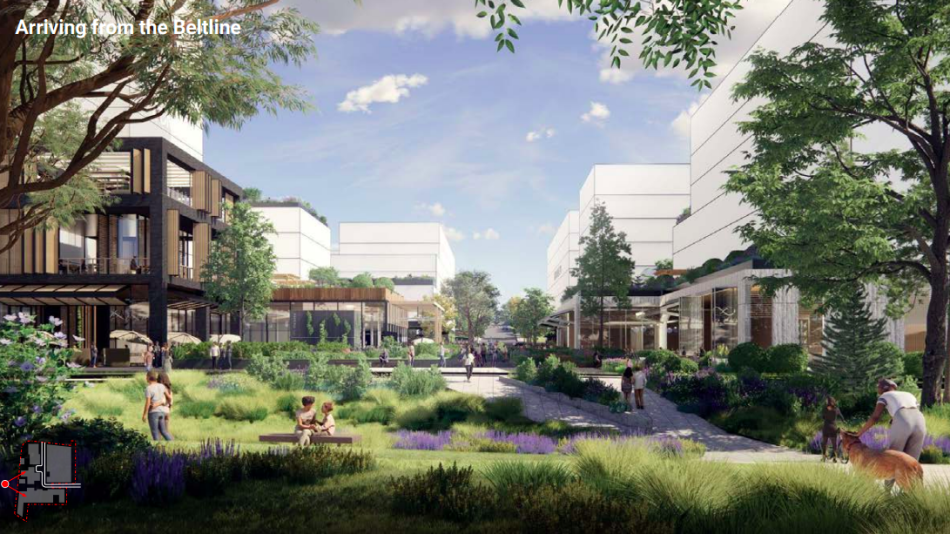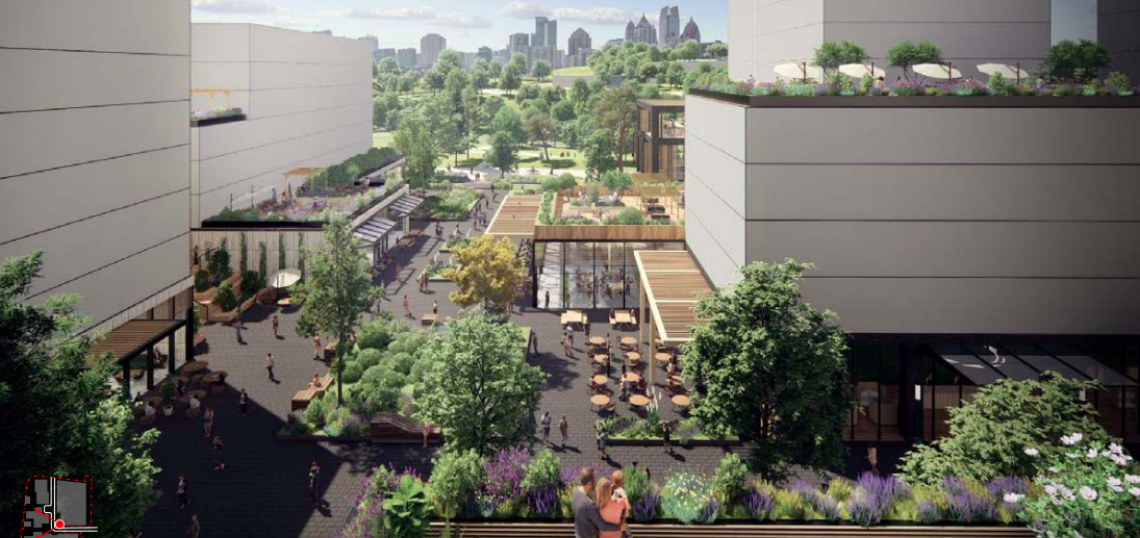Since the cat first peeked out of the bag in April, speculation has swirled over what Portman Holdings’ remake of Amsterdam Walk, a cherished but tired BeltLine-adjacent warehouse district, might actually entail.
Tentative answers, in general, came last month: A small forest of new buildings standing between seven and 17 stories (the latter nearest the BeltLine), 900 new apartments, and somewhere in the ballpark of 300,000 to 400,000 square feet of offices and 70,000 square feet of retail space, all separated by wide promenades and dotted with street-level patios. Also included: 1,400 parking spaces in new decks tucked between the BeltLine’s under-construction Northeast Trail and Monroe Drive.
The projected price tag: north of $750 million, spread across roughly 11 acres where the current Amsterdam Walk would be cleared away.
Portman filed a rezoning application with the city in late September.
Complaints from some residents in surrounding Virginia-Highland and Morningside neighborhoods have involved the increased vehicle traffic a project of such scale would inevitably bring. Other concerns have hinged on pedestrian and bicyclist safety in the area. And as Rough Draft Atlanta relayed earlier this week, residents on the border of Portman’s planned new district—those living on Orme Circle and Highland Park Lane, specifically—are upset the developer’s vision for density via much taller structures would block their views of Piedmont Park.
Mike Greene, Portman’s vice president of development, tells Urbanize Atlanta the only immediate next steps for the project involve continuing to work with the Virginia-Highland Civic Association and Morningside Lenox Park Association “to listen to people’s concerns and educate [them on] on our intentions.”
Greene said Portman would prefer to build the project all at once, but it will likely come in at least two phases, should it move forward as planned. And like the company’s plans for the Ponce de Leon corridor, changes are not expected to happen overnight.
“If everything went perfect from now to construction start, it would take about two years before you could start construction,” Greene wrote via email. “Of course, it’s very unlikely that things will go perfect. As you know, development is dependent on so many factors.”
 Plans to create a more seamless transition into the property from a Northeast Trail Atlanta BeltLine segment under construction now. SOM architects; courtesy of Portman Holdings
Plans to create a more seamless transition into the property from a Northeast Trail Atlanta BeltLine segment under construction now. SOM architects; courtesy of Portman Holdings
Greene pointed out the property is zoned C-1 (commercial business district) today, which would allow for roughly 1.3 million square feet of mostly commercial space across 11 acres, with little residential. C-1 has no maximum height restriction, he noted, except for the section of such properties in a Transitional Height Plane, which mandates that taller buildings have to step back away from lower densities next door at a 45-degree angle.
“Our proposal is to change the zoning from C to [MRC, or mixed-residential commercial], and actually keep the density close but change it to mostly residential and a little commercial. So basically flip-flop the commercial and residential entitlements,” Greene said.
“We would also be adding a max height and a previously nonexistent THP on the east property line between Amsterdam Walk and Highland Park [Lane],” he continued. “I feel like some people may be under the impression we're trying to up-zone the property to higher density. That isn’t actually what’s going on here at all.”
 Breakdown of Portman Holding's tentative redevelopment plans for Amsterdam Walk. SOM architects; courtesy of Portman Holdings
Breakdown of Portman Holding's tentative redevelopment plans for Amsterdam Walk. SOM architects; courtesy of Portman Holdings
Originally home to the Campbell Coal Company warehouses, the Amsterdam Walk district reopened as shops in the 1990s and was given its current name more than two decades ago.
Two years ago, Halpern Enterprises—Amsterdam Walk’s owner for nearly four decades—launched an initiative called “Reimagine Amsterdam Walk” to let Atlantans chime in about the property’s future. Portman Holdings later stepped up in hopes of purchasing and redeveloping the shopping center, taking advantage of its prime BeltLine and park frontage.
Portman officials have previously said they’ll walk away from the potential deal if they can’t reach common ground with surrounding neighborhoods, echoing the developers’ tactics with its Ponce-fronting development along the Eastside Trail.
In the gallery above, find a thorough breakdown of sectionalized site plans around the 11 acres in question, renderings by SOM architects depicting how a finished project might feel and function, and Kimley-Horn studies of traffic impacts on key surrounding streets, as provided by Portman this week.
...
Follow us on social media:
• Virginia-Highland news, discussion (Urbanize Atlanta)








